Leadership Research Essay: Transformational Leadership Analysis
VerifiedAdded on 2020/04/07
|6
|1397
|47
Essay
AI Summary
This essay delves into the realm of leadership, examining the theories and models proposed by prominent figures such as Kurt Lewin, Robert House, and Bernard Bass. It dissects the autocratic, democratic, and laissez-faire leadership styles of Lewin, the Path-Goal theory of House, and the transformational leadership model of Bass, highlighting their strengths and weaknesses. The essay explores the contextual challenges faced by leaders within each model, such as participation levels, goal setting, and motivation. It advocates for the transformational leadership style as the most relevant for contemporary organizations, emphasizing its lasting impact on individuals and organizational culture. The research employs a qualitative approach, relying on textual analysis and literature reviews to compare the models, while acknowledging limitations in practical application and empirical evidence. The essay concludes by underscoring the importance of transformational leadership in fostering employee awareness, teamwork, and sustained productivity, referencing successful examples from the business world.
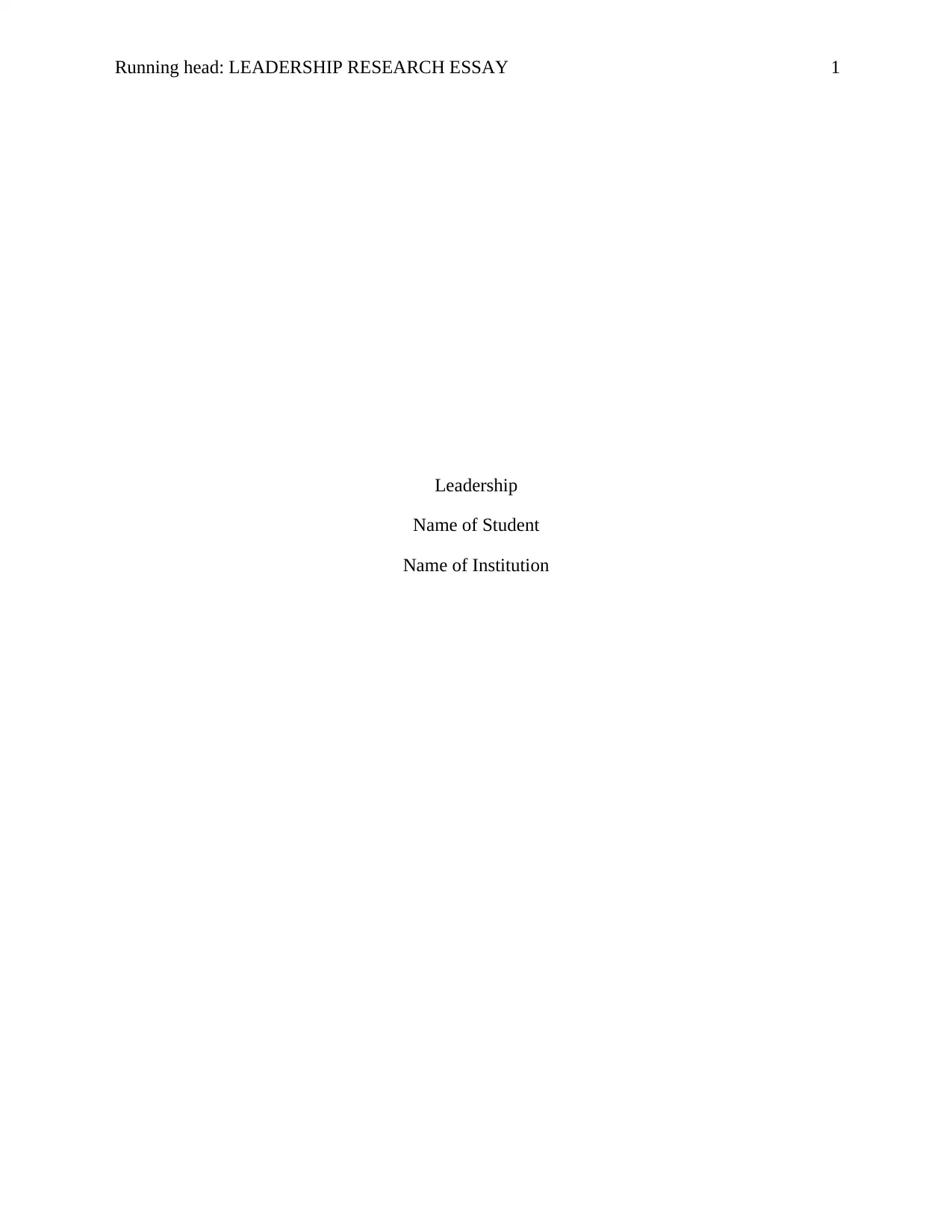
Running head: LEADERSHIP RESEARCH ESSAY 1
Leadership
Name of Student
Name of Institution
Leadership
Name of Student
Name of Institution
Paraphrase This Document
Need a fresh take? Get an instant paraphrase of this document with our AI Paraphraser
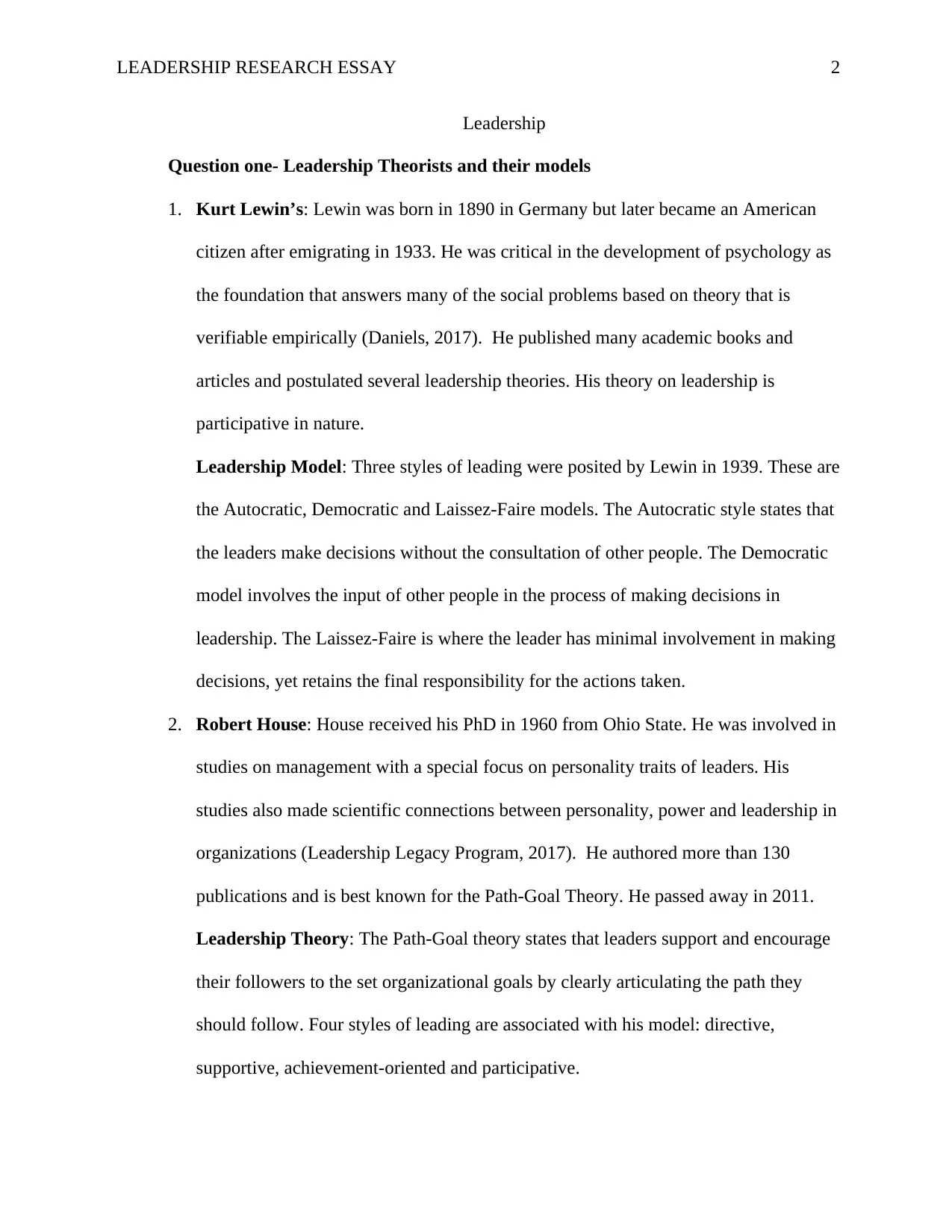
LEADERSHIP RESEARCH ESSAY 2
Leadership
Question one- Leadership Theorists and their models
1. Kurt Lewin’s: Lewin was born in 1890 in Germany but later became an American
citizen after emigrating in 1933. He was critical in the development of psychology as
the foundation that answers many of the social problems based on theory that is
verifiable empirically (Daniels, 2017). He published many academic books and
articles and postulated several leadership theories. His theory on leadership is
participative in nature.
Leadership Model: Three styles of leading were posited by Lewin in 1939. These are
the Autocratic, Democratic and Laissez-Faire models. The Autocratic style states that
the leaders make decisions without the consultation of other people. The Democratic
model involves the input of other people in the process of making decisions in
leadership. The Laissez-Faire is where the leader has minimal involvement in making
decisions, yet retains the final responsibility for the actions taken.
2. Robert House: House received his PhD in 1960 from Ohio State. He was involved in
studies on management with a special focus on personality traits of leaders. His
studies also made scientific connections between personality, power and leadership in
organizations (Leadership Legacy Program, 2017). He authored more than 130
publications and is best known for the Path-Goal Theory. He passed away in 2011.
Leadership Theory: The Path-Goal theory states that leaders support and encourage
their followers to the set organizational goals by clearly articulating the path they
should follow. Four styles of leading are associated with his model: directive,
supportive, achievement-oriented and participative.
Leadership
Question one- Leadership Theorists and their models
1. Kurt Lewin’s: Lewin was born in 1890 in Germany but later became an American
citizen after emigrating in 1933. He was critical in the development of psychology as
the foundation that answers many of the social problems based on theory that is
verifiable empirically (Daniels, 2017). He published many academic books and
articles and postulated several leadership theories. His theory on leadership is
participative in nature.
Leadership Model: Three styles of leading were posited by Lewin in 1939. These are
the Autocratic, Democratic and Laissez-Faire models. The Autocratic style states that
the leaders make decisions without the consultation of other people. The Democratic
model involves the input of other people in the process of making decisions in
leadership. The Laissez-Faire is where the leader has minimal involvement in making
decisions, yet retains the final responsibility for the actions taken.
2. Robert House: House received his PhD in 1960 from Ohio State. He was involved in
studies on management with a special focus on personality traits of leaders. His
studies also made scientific connections between personality, power and leadership in
organizations (Leadership Legacy Program, 2017). He authored more than 130
publications and is best known for the Path-Goal Theory. He passed away in 2011.
Leadership Theory: The Path-Goal theory states that leaders support and encourage
their followers to the set organizational goals by clearly articulating the path they
should follow. Four styles of leading are associated with his model: directive,
supportive, achievement-oriented and participative.
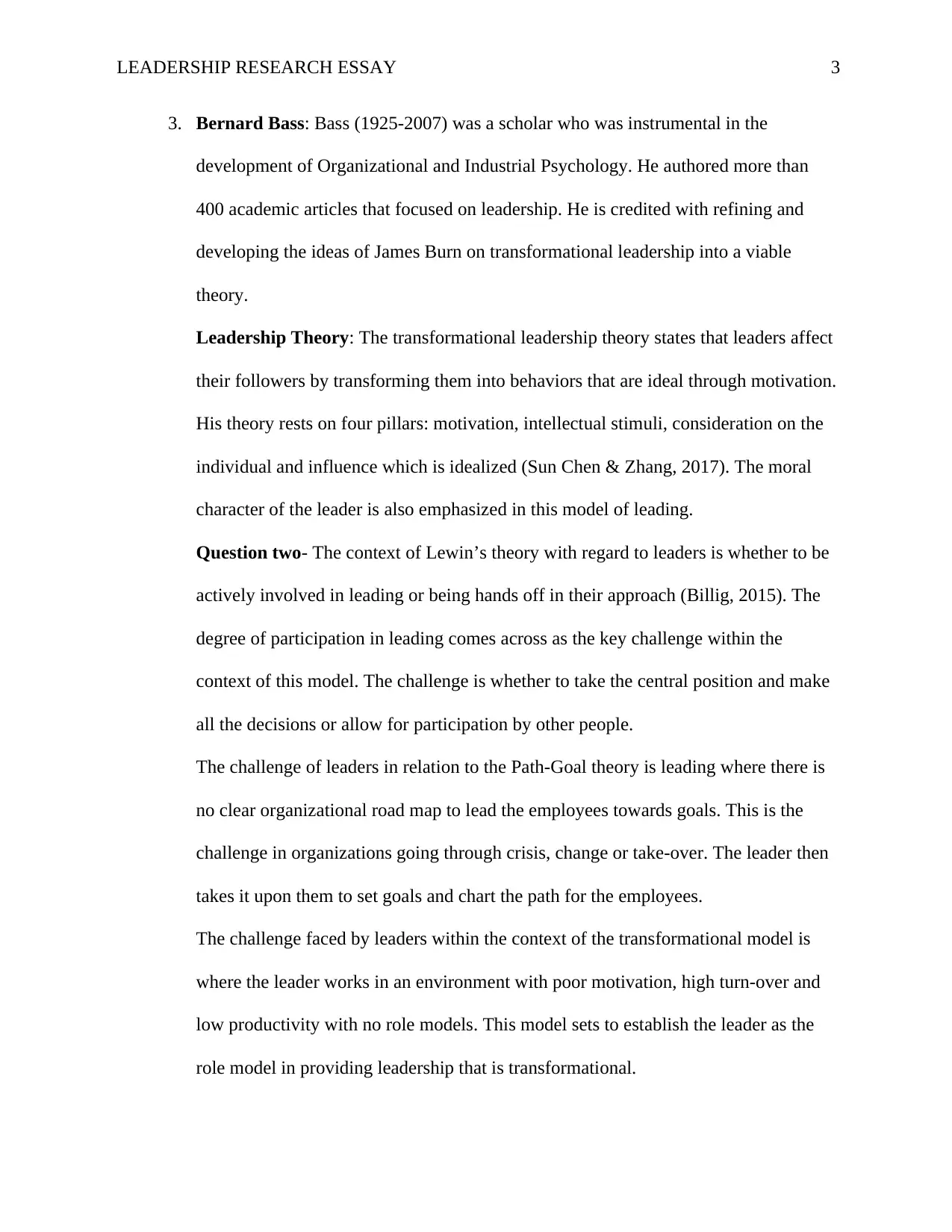
LEADERSHIP RESEARCH ESSAY 3
3. Bernard Bass: Bass (1925-2007) was a scholar who was instrumental in the
development of Organizational and Industrial Psychology. He authored more than
400 academic articles that focused on leadership. He is credited with refining and
developing the ideas of James Burn on transformational leadership into a viable
theory.
Leadership Theory: The transformational leadership theory states that leaders affect
their followers by transforming them into behaviors that are ideal through motivation.
His theory rests on four pillars: motivation, intellectual stimuli, consideration on the
individual and influence which is idealized (Sun Chen & Zhang, 2017). The moral
character of the leader is also emphasized in this model of leading.
Question two- The context of Lewin’s theory with regard to leaders is whether to be
actively involved in leading or being hands off in their approach (Billig, 2015). The
degree of participation in leading comes across as the key challenge within the
context of this model. The challenge is whether to take the central position and make
all the decisions or allow for participation by other people.
The challenge of leaders in relation to the Path-Goal theory is leading where there is
no clear organizational road map to lead the employees towards goals. This is the
challenge in organizations going through crisis, change or take-over. The leader then
takes it upon them to set goals and chart the path for the employees.
The challenge faced by leaders within the context of the transformational model is
where the leader works in an environment with poor motivation, high turn-over and
low productivity with no role models. This model sets to establish the leader as the
role model in providing leadership that is transformational.
3. Bernard Bass: Bass (1925-2007) was a scholar who was instrumental in the
development of Organizational and Industrial Psychology. He authored more than
400 academic articles that focused on leadership. He is credited with refining and
developing the ideas of James Burn on transformational leadership into a viable
theory.
Leadership Theory: The transformational leadership theory states that leaders affect
their followers by transforming them into behaviors that are ideal through motivation.
His theory rests on four pillars: motivation, intellectual stimuli, consideration on the
individual and influence which is idealized (Sun Chen & Zhang, 2017). The moral
character of the leader is also emphasized in this model of leading.
Question two- The context of Lewin’s theory with regard to leaders is whether to be
actively involved in leading or being hands off in their approach (Billig, 2015). The
degree of participation in leading comes across as the key challenge within the
context of this model. The challenge is whether to take the central position and make
all the decisions or allow for participation by other people.
The challenge of leaders in relation to the Path-Goal theory is leading where there is
no clear organizational road map to lead the employees towards goals. This is the
challenge in organizations going through crisis, change or take-over. The leader then
takes it upon them to set goals and chart the path for the employees.
The challenge faced by leaders within the context of the transformational model is
where the leader works in an environment with poor motivation, high turn-over and
low productivity with no role models. This model sets to establish the leader as the
role model in providing leadership that is transformational.
⊘ This is a preview!⊘
Do you want full access?
Subscribe today to unlock all pages.

Trusted by 1+ million students worldwide
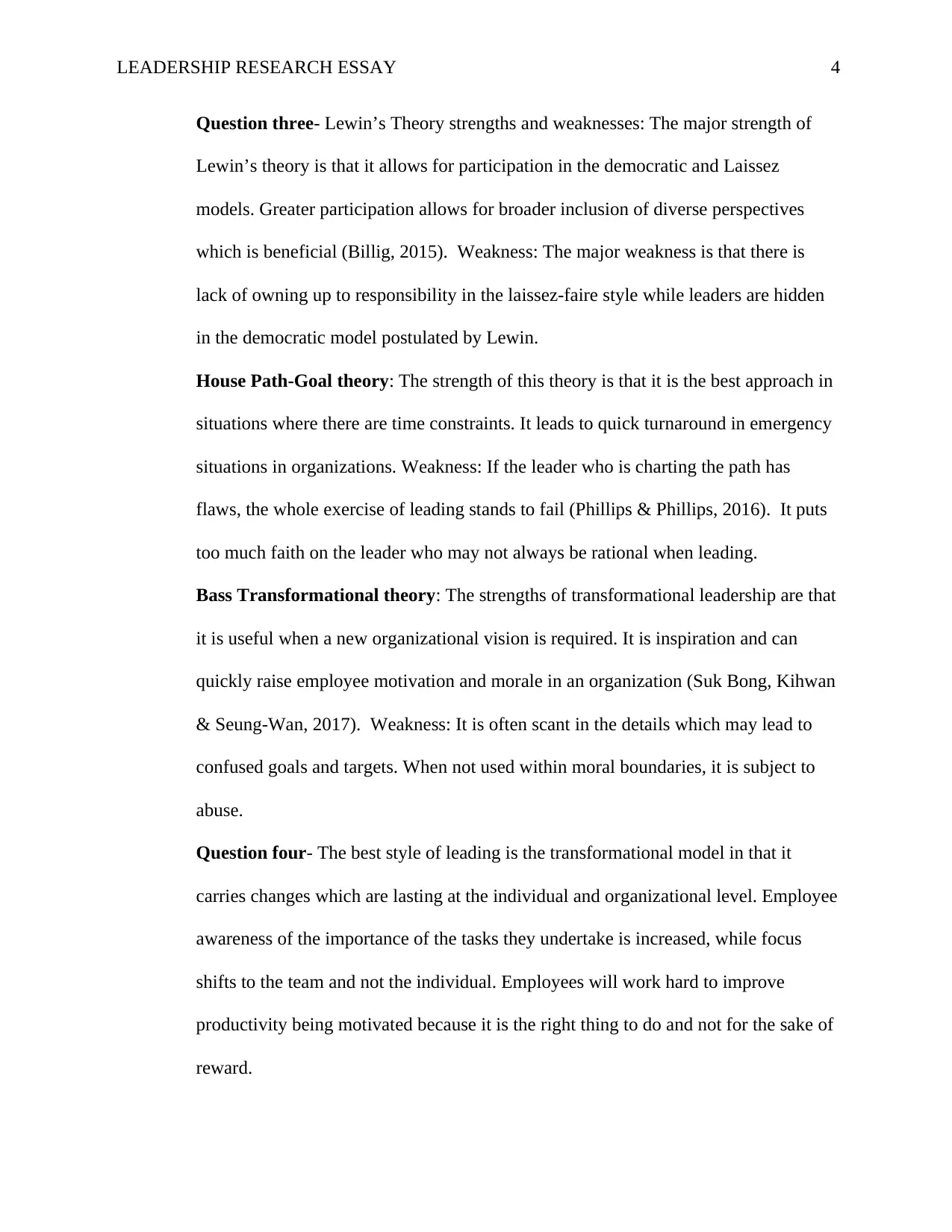
LEADERSHIP RESEARCH ESSAY 4
Question three- Lewin’s Theory strengths and weaknesses: The major strength of
Lewin’s theory is that it allows for participation in the democratic and Laissez
models. Greater participation allows for broader inclusion of diverse perspectives
which is beneficial (Billig, 2015). Weakness: The major weakness is that there is
lack of owning up to responsibility in the laissez-faire style while leaders are hidden
in the democratic model postulated by Lewin.
House Path-Goal theory: The strength of this theory is that it is the best approach in
situations where there are time constraints. It leads to quick turnaround in emergency
situations in organizations. Weakness: If the leader who is charting the path has
flaws, the whole exercise of leading stands to fail (Phillips & Phillips, 2016). It puts
too much faith on the leader who may not always be rational when leading.
Bass Transformational theory: The strengths of transformational leadership are that
it is useful when a new organizational vision is required. It is inspiration and can
quickly raise employee motivation and morale in an organization (Suk Bong, Kihwan
& Seung-Wan, 2017). Weakness: It is often scant in the details which may lead to
confused goals and targets. When not used within moral boundaries, it is subject to
abuse.
Question four- The best style of leading is the transformational model in that it
carries changes which are lasting at the individual and organizational level. Employee
awareness of the importance of the tasks they undertake is increased, while focus
shifts to the team and not the individual. Employees will work hard to improve
productivity being motivated because it is the right thing to do and not for the sake of
reward.
Question three- Lewin’s Theory strengths and weaknesses: The major strength of
Lewin’s theory is that it allows for participation in the democratic and Laissez
models. Greater participation allows for broader inclusion of diverse perspectives
which is beneficial (Billig, 2015). Weakness: The major weakness is that there is
lack of owning up to responsibility in the laissez-faire style while leaders are hidden
in the democratic model postulated by Lewin.
House Path-Goal theory: The strength of this theory is that it is the best approach in
situations where there are time constraints. It leads to quick turnaround in emergency
situations in organizations. Weakness: If the leader who is charting the path has
flaws, the whole exercise of leading stands to fail (Phillips & Phillips, 2016). It puts
too much faith on the leader who may not always be rational when leading.
Bass Transformational theory: The strengths of transformational leadership are that
it is useful when a new organizational vision is required. It is inspiration and can
quickly raise employee motivation and morale in an organization (Suk Bong, Kihwan
& Seung-Wan, 2017). Weakness: It is often scant in the details which may lead to
confused goals and targets. When not used within moral boundaries, it is subject to
abuse.
Question four- The best style of leading is the transformational model in that it
carries changes which are lasting at the individual and organizational level. Employee
awareness of the importance of the tasks they undertake is increased, while focus
shifts to the team and not the individual. Employees will work hard to improve
productivity being motivated because it is the right thing to do and not for the sake of
reward.
Paraphrase This Document
Need a fresh take? Get an instant paraphrase of this document with our AI Paraphraser
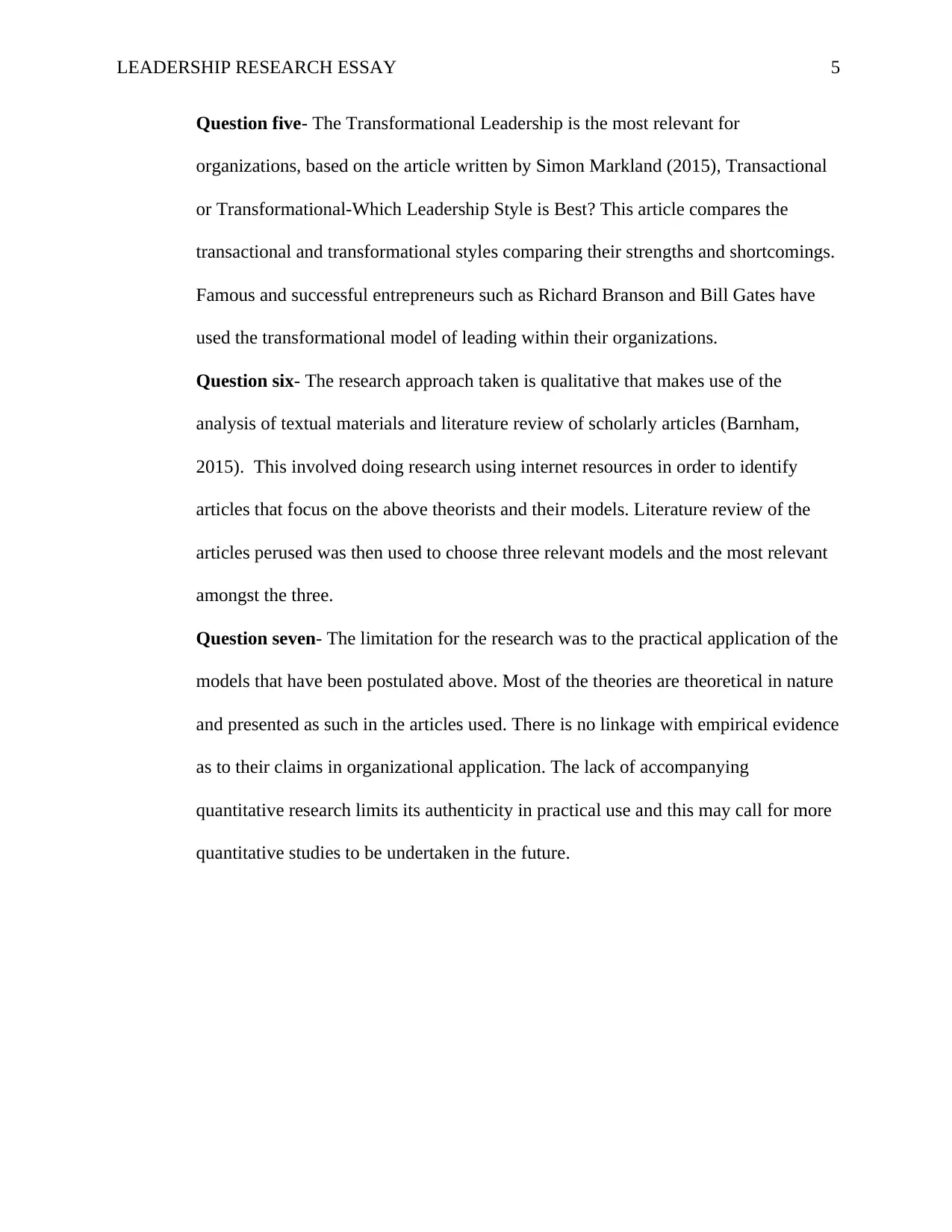
LEADERSHIP RESEARCH ESSAY 5
Question five- The Transformational Leadership is the most relevant for
organizations, based on the article written by Simon Markland (2015), Transactional
or Transformational-Which Leadership Style is Best? This article compares the
transactional and transformational styles comparing their strengths and shortcomings.
Famous and successful entrepreneurs such as Richard Branson and Bill Gates have
used the transformational model of leading within their organizations.
Question six- The research approach taken is qualitative that makes use of the
analysis of textual materials and literature review of scholarly articles (Barnham,
2015). This involved doing research using internet resources in order to identify
articles that focus on the above theorists and their models. Literature review of the
articles perused was then used to choose three relevant models and the most relevant
amongst the three.
Question seven- The limitation for the research was to the practical application of the
models that have been postulated above. Most of the theories are theoretical in nature
and presented as such in the articles used. There is no linkage with empirical evidence
as to their claims in organizational application. The lack of accompanying
quantitative research limits its authenticity in practical use and this may call for more
quantitative studies to be undertaken in the future.
Question five- The Transformational Leadership is the most relevant for
organizations, based on the article written by Simon Markland (2015), Transactional
or Transformational-Which Leadership Style is Best? This article compares the
transactional and transformational styles comparing their strengths and shortcomings.
Famous and successful entrepreneurs such as Richard Branson and Bill Gates have
used the transformational model of leading within their organizations.
Question six- The research approach taken is qualitative that makes use of the
analysis of textual materials and literature review of scholarly articles (Barnham,
2015). This involved doing research using internet resources in order to identify
articles that focus on the above theorists and their models. Literature review of the
articles perused was then used to choose three relevant models and the most relevant
amongst the three.
Question seven- The limitation for the research was to the practical application of the
models that have been postulated above. Most of the theories are theoretical in nature
and presented as such in the articles used. There is no linkage with empirical evidence
as to their claims in organizational application. The lack of accompanying
quantitative research limits its authenticity in practical use and this may call for more
quantitative studies to be undertaken in the future.
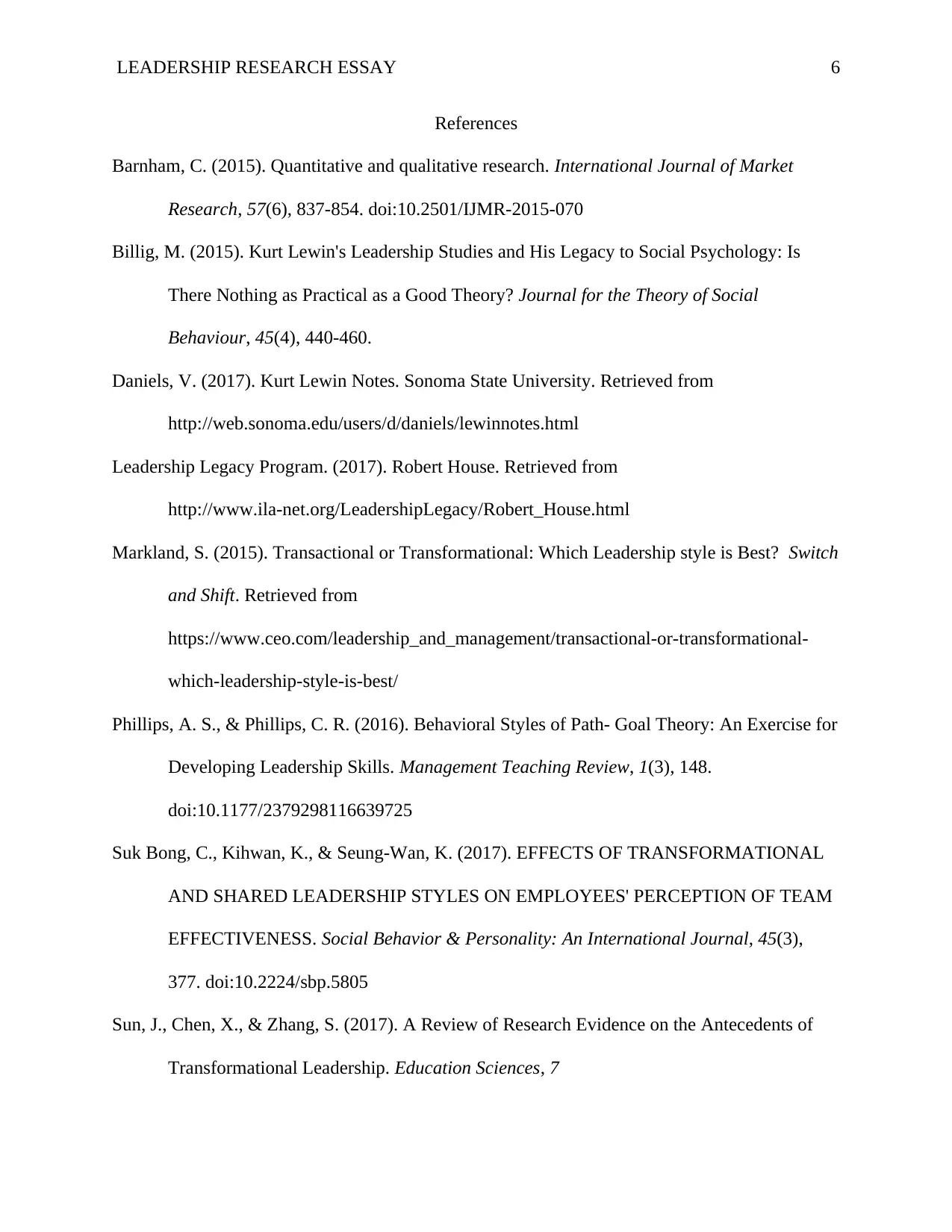
LEADERSHIP RESEARCH ESSAY 6
References
Barnham, C. (2015). Quantitative and qualitative research. International Journal of Market
Research, 57(6), 837-854. doi:10.2501/IJMR-2015-070
Billig, M. (2015). Kurt Lewin's Leadership Studies and His Legacy to Social Psychology: Is
There Nothing as Practical as a Good Theory? Journal for the Theory of Social
Behaviour, 45(4), 440-460.
Daniels, V. (2017). Kurt Lewin Notes. Sonoma State University. Retrieved from
http://web.sonoma.edu/users/d/daniels/lewinnotes.html
Leadership Legacy Program. (2017). Robert House. Retrieved from
http://www.ila-net.org/LeadershipLegacy/Robert_House.html
Markland, S. (2015). Transactional or Transformational: Which Leadership style is Best? Switch
and Shift. Retrieved from
https://www.ceo.com/leadership_and_management/transactional-or-transformational-
which-leadership-style-is-best/
Phillips, A. S., & Phillips, C. R. (2016). Behavioral Styles of Path- Goal Theory: An Exercise for
Developing Leadership Skills. Management Teaching Review, 1(3), 148.
doi:10.1177/2379298116639725
Suk Bong, C., Kihwan, K., & Seung-Wan, K. (2017). EFFECTS OF TRANSFORMATIONAL
AND SHARED LEADERSHIP STYLES ON EMPLOYEES' PERCEPTION OF TEAM
EFFECTIVENESS. Social Behavior & Personality: An International Journal, 45(3),
377. doi:10.2224/sbp.5805
Sun, J., Chen, X., & Zhang, S. (2017). A Review of Research Evidence on the Antecedents of
Transformational Leadership. Education Sciences, 7
References
Barnham, C. (2015). Quantitative and qualitative research. International Journal of Market
Research, 57(6), 837-854. doi:10.2501/IJMR-2015-070
Billig, M. (2015). Kurt Lewin's Leadership Studies and His Legacy to Social Psychology: Is
There Nothing as Practical as a Good Theory? Journal for the Theory of Social
Behaviour, 45(4), 440-460.
Daniels, V. (2017). Kurt Lewin Notes. Sonoma State University. Retrieved from
http://web.sonoma.edu/users/d/daniels/lewinnotes.html
Leadership Legacy Program. (2017). Robert House. Retrieved from
http://www.ila-net.org/LeadershipLegacy/Robert_House.html
Markland, S. (2015). Transactional or Transformational: Which Leadership style is Best? Switch
and Shift. Retrieved from
https://www.ceo.com/leadership_and_management/transactional-or-transformational-
which-leadership-style-is-best/
Phillips, A. S., & Phillips, C. R. (2016). Behavioral Styles of Path- Goal Theory: An Exercise for
Developing Leadership Skills. Management Teaching Review, 1(3), 148.
doi:10.1177/2379298116639725
Suk Bong, C., Kihwan, K., & Seung-Wan, K. (2017). EFFECTS OF TRANSFORMATIONAL
AND SHARED LEADERSHIP STYLES ON EMPLOYEES' PERCEPTION OF TEAM
EFFECTIVENESS. Social Behavior & Personality: An International Journal, 45(3),
377. doi:10.2224/sbp.5805
Sun, J., Chen, X., & Zhang, S. (2017). A Review of Research Evidence on the Antecedents of
Transformational Leadership. Education Sciences, 7
⊘ This is a preview!⊘
Do you want full access?
Subscribe today to unlock all pages.

Trusted by 1+ million students worldwide
1 out of 6
Related Documents
Your All-in-One AI-Powered Toolkit for Academic Success.
+13062052269
info@desklib.com
Available 24*7 on WhatsApp / Email
![[object Object]](/_next/static/media/star-bottom.7253800d.svg)
Unlock your academic potential
Copyright © 2020–2025 A2Z Services. All Rights Reserved. Developed and managed by ZUCOL.



